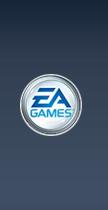|
This tutorial will walk you through the necessary steps
to add a new air vehicle into Battlefield: 1942 (BF: 1942). You will learn
how to set up a new air vehicle, configure the inner workings of the vehicle
and place it in-game. The tutorial will show how to add a new air vehicle
named “F16” into the game based on the existing “Zero” air vehicle which
is already in BF: 1942. As a result of what you will learn in this tutorial,
you will be able to modify air vehicle files in any way to add a limitless
amount of new air vehicles into BF:1942.
PREPARATION:
This tutorial assumes that you have used the winRFA
extraction tool from the Mod Development Toolkit to extract the “Objects.rfa”
file into the base directory of your BF:1942 installation.For reference
purposes, we will assume that your base installation directory is the
default installation directory (Program Files\EA Games\Battlefield 1942\).
We need to begin by setting up the necessary directory and file structure.
- Enter the “Objects\Vehicles\Air” directory.
- Copy the “Zero” directory.
- Rename the new directory to “F16”.
- Enter the “F16” directory.
Within the “F16” directory, there are five files and
two directories. The five files are “Objects.con”, “Physics.con”, “Network.con”,
“Weapons.con” and “Geometries.con”. The directories are “Sounds” and “AI”.
All of these items will need to be edited to create a new sea vehicle.
STEP 1: Objects.con Scripting Changes
- Open the “Objects.con” file.

The second line, “ObjectTemplate.create PlayerControlObject
Zero”, begins the creation of a player-controllable object named “Zero”.
The lines directly following the creation of this object configure some
of the settings that will be applied to this vehicle, including the vehicle’s
mass, amount of hitpoints and drag, etc. These lines also define the special
effects that the “Zero” will have and when they will occur. For example,
the line “ObjectTemplate.addArmorEffect 65 em_ZeroDamage 0/0.202/2” says
that when the “Zero” drops to 65 hitpointsthe “em_ZeroDamage” special
effect (contained in the “Objects\Effects\” folder) will occur at position
“0/0.202/2”.
The line “ObjectTemplate.addTemplate lodZero” adds
a “Level of Detail” object that will contain the rest of the vehicle.
The line “ObjectTemplate.setVehicleIcon” sets the location of the image
file that will be used to represent the vehicle. This icon will be displayed
in the lower left-hand corner of the screen next to the health bar for
the vehicle. Changing the numerical value in the “ObjectTemplate.setVehicleIconPos”
line can be used to adjust position of the dot on the image.
The “VehicleCategory” is “VCAir” and the “VehicleType”
is set to “VTFighter”. The settings of these lines determine what controls
the vehicle will use. This vehicle will utilize the controls that were
configured in the “Air Controls” menu in BF:1942. The line “ObjectTemplate.setMinimapIcon”
sets the location of the image file that will be used to represent this
vehicle on the minimap that appears in the upper right-hand of the screen.

The next section in this file is the creation of the
“LodObject”. This object defines three different ways that the vehicle
will appear to a user; ZeroComplex – close range, ZeroSimple– long range
and Zerowreck – when destroyed. The order of these items is very important.The
main object (Complex) is always first, followed by the low-polygon object
(Simple) and ending with the wrecked version of the vehicle.

The creation of the “ZeroComplex” bundle is integral
to the functionality of the vehicle. This bundle adds templates (via the
“ObjectTemplate.addTemplate” lines) that include the engine, how a user
will enter/exit the vehicle, etc. The line below each “addTemplate” line
(“ ObjectTemplate.setPosition”) is the position of each item in relation
to the center-point of the vehicle. The engine, flaps, wings, guns and
bombs are only a few of the things that are added into this object so
that the driver of the vehicle will have control over all of them.

These next five sections set up the vehicle’s cockpit
and how it will be seen. “lodZeroCockpit” is the object that contains
both the internal and external view of the cockpit as well as the “lodSelector”
object that decides which cockpit will be seen by each player. The “ZeroCockpitExternal”
line defines what model a player will see when outside the vehicle and
the “ ZeroCockpitInternal” line displays a different (more detailed) model
to the player who is inside the vehicle. Notice that each object (“ZeroCockpitExternal”
and “ZeroCockpitInternal”) uses a different model via the “ObjectTemplate.geometry”
line.Finally, the “ZeroCockpitSelector” is the object that decides which
cockpit view will be seen by which player.

The Camera created in the image above (“ZeroCamera”)
is the object that defines the ability to see for the driver of the vehicle.
This object sets how far the player can look to the right or left as well
as up and down via the “setMinRotation” and “ setMaxRotation” lines. The
next object created in this image is the EntryPoint. Without an entry
point, no player could enter this vehicle. The radius set within this
object defines how close a player needs to be to the vehicle before he
can enter it. The last object created is the SeatObject. This object sets
the flags for the player while he is in the vehicle. The flag “c_SeatShowHalfBodySoldier”
means that anyone looking at the vehicle will see half of the body of
the player. If the flag was set as “c_SeatShowFullBodySoldier”, the whole
body would appear.
Each of these objects is included in the “ZeroComplex”
bundle that we looked at earlier.Because “ZeroComplex” is part of the
“PlayerControlObject Zero”, all of these configurations apply to the driver
of the vehicle.

The “lodZeroPropeller” is another “LOD” object
that contains two ways to view the propeller (static and blurred) and
includes the “lodSelector” which decides when to show each particular
view. As you will see later in the tutorial, the “lodZeroPropeller” object
is added into the engine of the vehicle so that the movement f the propeller
will be dependant on the speed of the engine.
There are two “SimpleObject” creations which contain
the geometry for the two views of the propeller (static and blurred).
The final object created is the “ZeroPropSelector”. This is the “Selector”
which will actually make the decision on which propeller to show at any
given time.

The next two objects created are “LandingGear”
objects for the right and left side of the air vehicle. Both objects have
a model associated with them (via the “ObjectTemplate.geometry” line)
as well as the “Min” rotation(right gear) and “Max” rotation (left gear)
values set.
***NOTE: In each landing gear object, a “ZeroWheel”
object is added. We will review these objects when we review the “Physics.con”
file.
The line “ObjectTemplate.setGearUpHeight” sets how
far off the ground the air vehicle must be before the landing gear will
be raised. In addition, the “ObjectTemplate.setGearDownEngineInput” defines
how the slow the engine must be going before the gear will be lowered.

Thelast “LandingGear” object is for the back wheel.
The setup is essentially the same as the other wheels, with the exception
that the back wheel has both a rotational bundle and a spring whereas
the front two wheels only have springs. Additionally, the line “ObjectTemplate.setInputToYaw
c_PIYaw” indicates that the movement of the back wheel (used to turn the
air vehicle) will be controlled by whatever input device is bound to the
“Yaw” controls in the “Air Controls” menu of BF:1942.

The final part of this file contains the creation of
the final two Simple Objects that were included in the LodObject “lodZero”.
Simple Objects usually just refer to the geometry object, in this case
“ZeroSimple” refers to the low-polygon model of the vehicle hull and “ZeroWreck”
refers to the wrecked model. The “ZeroLodSelector” that is created at
the bottom of the file is the selector used for the “lodZero” object.
Notice that there is an additional line, “LodSelectorTemplate.hasDestroyedLod
1”, which tells the game engine that, in addition to the standard model
and low-polygon model, there is a wrecked model which must be shown.
Now that we have reviewed how everything in the “Objects.con”
file works, lets make the necessary changes to create a new vehicle named
“F16” for BF:1942.
- With the exception of any lines that begin with
“ObjectTemplate.addArmorEffect” or “ObjectTemplate.setVehicleIcon”,
replace all instances of “Zero” in this file with “F16”.
- Close and save the “Objects.con” file.
STEP 2: Physics.con Scripting Changes
The “Physics.con” file contains objects that define
the physics of the vehicle. Included in this file are the engine, wheels,
flaps and rudder configurations.
- Open the “Physics.con” file.

The Engine is what makes the vehicle move in-game.
Remember that the “ZeroEngine” was included in the “Objects.con” file
as part of the “ZeroComplex” bundle. This means that the driver of the
vehicle will have control over the Engine. There are four templates added
to the engine object: “lodZeroPropeller”, “ZeroLandingGearLeft”, “ZeroLandingGearRight”
and “ZeroLandingGearBack”.
The Min and Max rotation on an engine represent the
maximum speed that the vehicle can attain while going forward (Max) or
backward (Min). ObjectTemplate.setEngineType c_ETPlane” sets the type
of engine that the vehicle will be using. In contrast, a jeep uses the
“c_ETCar” engine. Below the engine type, you can set the engine torque,
differential, number of gears, and the gear ratio. These items can be
changed at anytime to adjust the feel of the vehicle.
***NOTE: If the air vehicle drops below a certain
speed, the propeller will switch back to its static state and appear to
not be moving. This effect is handled via the “ObjectTemplate.setNoPropellerEffectAtSpeed
70” line.
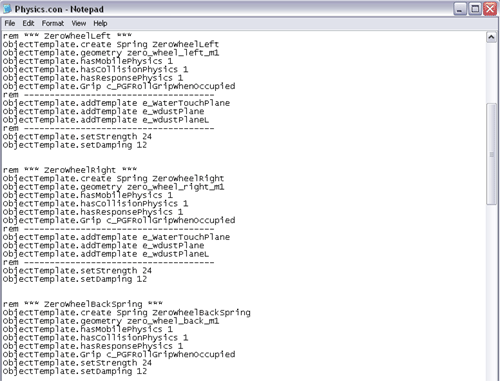
The next three objects are the springs that are included
in the “ZeroLandingGearRight”, “ZeroLandingGearLeft” and “ZeroLandingGearBack”
objects we reviewed in the “Objects.con” file. Each of the springs have
an “ObjectTemplate.Grip” line. This enables these springs (wheels) to
grip the ground and use that traction to move the vehicle. The two “ObjectTemplate.addTemplate”
lines in each spring configuration are the special effects that will be
seen when the tires have contact with either water or the ground.

This image is an example of the rest of the “>Physics.con” file. The
remainder of the file configures the flaps and rudders used to maneuver
the air vehicle. Each of the “Wing” objects uses a model (“ObjectTemplate.geometry”
line), sets the “Min” and “Max” rotation for the model and sets how much
lift one of these flaps could cause to the vehicle. The lift power is
handled via the “ObjectTemplate.setWingLife” and “ObjectTemplate.setFlapLift”
lines. The values in these lines can be adjusted to completely change
the way this vehicle handles while in the air.
Now that we have reviewed how the objects in the “Physics.con” file work,
let’s make the necessary changes so that these objects can be used in
our new vehicle.
- Replace every instance of “Zero” in the file with
“F16”.
- Close and save the “Physics.con” file.
STEP 3: Geometries.con Scripting Changes
The “Geometries.con” file contains all of the geometry
objects to which the “Objects.con” and “Physics.con” file refer. Our next
step will be to open this file and make the necessary changes.
- Open the “Geometries.con” file
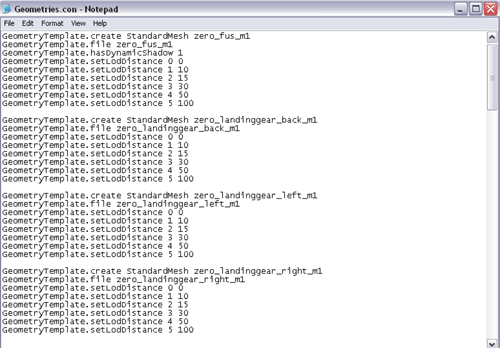
Note that each object starts with the line “ GeometryTemplate.create
StandardMesh”. >StandardMesh is the object that contains the model seen
in-game. The second line in each Geometry object is “GeometryTemplate.file”.
The line is ended by the filename of the model. The default folder for
the model files is the “StandardMesh” directory which is contained in
the “StandardMesh.rfa” file. If you wanted to put a different body in
place of the standard Zero body, place the new exported model file into
the “StandardMesh” directory and then adjust the “GeometryTemplate.file
zero_fus_m1” line to read “GeometryTemplate.file newfilename”.
Let’s make the changes needed for this new vehicle
to work in-game.
- In line 1, replace “Zero” with “F16”.
- In every line that begins with “GeometryTemplate.create
StandardMesh”,replace “Zero” with “F16”.
- Close and save the “Geometries.con” file.
STEP 4: Network.con Scripting Changes
The last file we will need to make changes to is the
“Network.con” file.
- Open the “Network.con” file.

This file contains the network objects that will transmit
the vehicle data in a multiplayer game. Each of the network objects created
in this file were part of major portions of the objects created in the
“Objects.con” and “Physics.con” files. You will find these network objects
in those files in lines that begin with “ObjectTemplate.setNetworkableInfo”.
We need to make the appropriate changes in this file to make sure this
new vehicle can be used in a multiplayer game.
- Replace “Zero” in every line with “F16”.
- Close and save the “Network.con” file.
STEP 5: Weapons.con Scripting Changes
The “Weapons.con” file contains all of the weapon configurations
that the “Zero” vehicle uses.
- Open the “Weapons.con” file.
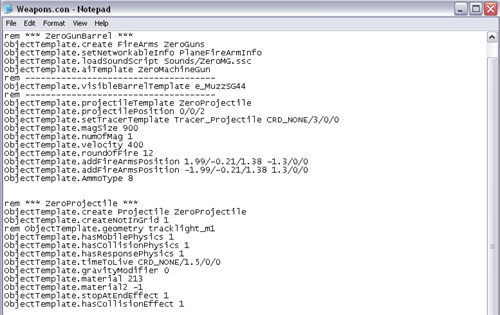
The second line creates the weapon with the “ObjectTemplate.create
Firearms” line.The “ObjectTemplate.visibleBarrelTemplate e_MuzzSG44” defines
the muzzle flash that will be seen every time the machine gun is fired.
ObjectTemplate.projectile ZeroProjectile” defines the type of projectile
(bullet) that this weapon will fire and the “ObjectTemplate.projectilePosition”
line defines the position at which the projectile will be created when
fired. The weapon has a maximum of 900 bullets that it can hold (defined
via “magSize”) and the bullets are fired at a velocity of “400” (defined
via “velocity”).The “ObjectTemplate.roundofFire” line defines how quickly
the weapon can fire multiple shots. The lower the value, the slower the
rate of fire. Because this air vehicle has a machine gun mounted on both
sides of the fuselage, we use the “ObjectTemplate.addFireArmsPosition”
line to position more than one instance of this weapon on the plane. This
way, you can have more than one instance but both will be fired by the
same controls at the same time.
The next object created is the projectile object.
This sets up the configuration of the projectile (bullet) that will be
fired by the air vehicle’s machine gun. The projectile needs to have Mobile,
Collision and Response physics so that it will be able to move and interact
when it collides with a target. These values are set to “1” (“0” is off,
“1” is on). The “ ObjectTemplate.timeToLive ” line defines how long this
projectile will last before it will disappear. By setting a time limit
on the projectile’s life, it prevents projectiles from staying in the
game perpetually and affecting the games performance. The material setting
defines how this projectile will damage other types of material. For example,
this type of projectile would have more of an effect on a body versus
a tank. ObjectTemplate.stopAtEndEffect 1” means that the projectile will
cease to exist once it has collided with something and caused it’s damage.

The “ZeroBombDummy” firearm is the second firearm that
this vehicle has. It uses the generic “FighterBomb” projectile template
that many of the BF:1942 planes share (The configuration for this projectile
can be found in the “\Objects\Vehicles\Common\Weapons.con” file). Notice
that this firearm configuration uses a lot of the same types of settings
as the “ZeroGuns” firearms we looked at above. This bomb firearm is fired
using the “AltFire” button. This is defined within the “ObjectTemplate.setInputFire
c_PIAltFire” line.
- Replace every instance of “Zero” with “F16”
- Save and close the “Weapons.con” file.
STEP 6: Sound Configuration
The next step in setting up this new vehicle is making
the necessary changes to the Sound files. All sound effect settings are
contained in the “Sounds” subdirectory of each vehicle’s main folder.
BF: 1942 has three different settings for sound. You can choose 11 khz
(Low), 22 khz (Medium) or 44 khz (High). The “Sounds” directory contains
eight files.
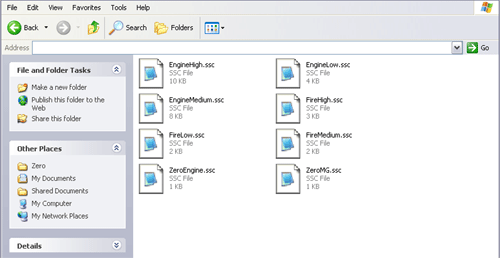
Four of the files are sound configurations for the
engine (“ZeroEngine”, “EngineLow”, “EngineMedium”, “EngineHigh”) and four
files are sound configurations for the machine gun(“ZeroMG”, “FireLow”,
“FireMedium”, “FireHigh”). Within each set of four files, the three files
containing the words “Low”, “Medium” and “High” correspond to the settings
11 khz, 22 khzand 44 khz settings mentioned above.

The fourth file is the central sound file that includes
all the settings from the other three sound files. The image shows that
the “ZeroEngine.ssc” fileincludes all of the other engine files.
- Rename the file “ZeroEngine.ssc” to “F16Engine.ssc”.
- Rename the file “ZeroMG.ssc” to “F16MG.ssc”.
- Leave this directory and return to the main “F16”
directory.
STEP 7: AI Configuration
The final step is to configure the Artificial Intelligence
(AI). The AI for this vehicle is contained in the AI directory in the
“Objects.con” and “Weapons.con” files. These files contain AI configurations
for how bots will drive the vehicle, fire the weapons, react to the opposing
team, etc. Enter the “AI” directory.
- Open the “Objects.con” file.
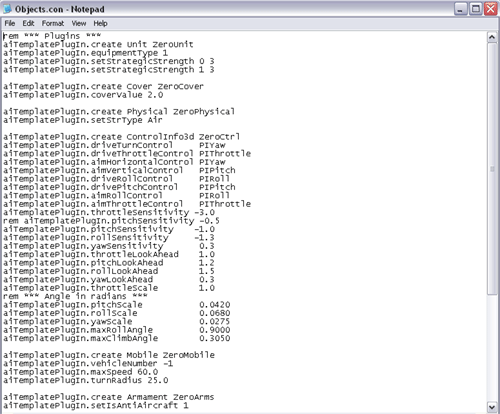
- Change every instance of “Zero” to “F16”.
- Close and save the “Objects.con” file.
- Open the “Weapons.con”.
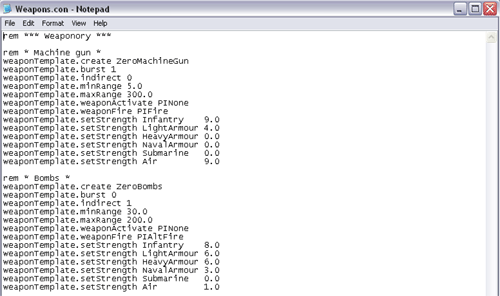
- Change every instance of “Zero” to “F16”.
- Close and save the “Weapons.con” file.
Now that all off the proper changes have been made,
this new air vehicle named “F16” can be added into the game. A new “Objects.rfa”
file will need to be created that includes these new configuration files.
This can be done using the winRFA tool from the Mod Development Toolkit.
This tutorial has shown the intricacies of a BF:1942
air vehicle. A basic air vehicle in BF :1942 only requires the following
items: a Player Controllable Object, an Engine, wheels (springs), a Seat,
a Camera (the drivers viewpoint while operating the vehicle) and an Entry
Point (how a player will enter the vehicle). Additional items that can
be added increase the realism of a vehicle and make it more fun to operate.
STEP 8: Examples
Now that we have named our new air vehicle “F16”, we
should make it more like the real-life “F16”. One major things we need
to change is the speed of this vehicle. The “F16” is much faster than
any original BF:1942 plane, so let’s change our new vehicle appropriately.
- Open the “Physics.con” file.

Changing the speed involves two lines within the “F16Engine”
file. The first line we need to change, “ ObjectTemplate.setMaxSpeed ”,
sets the maximum speed that this vehicle can travel. The second line we
need to change, “ObjectTemplate.setTorque”, defines how fast the vehicle
will accelerate.
- In the line “ObjectTemplate.setMaxSpeed1000/0/500”,
change the values to “2000/0/4000”.
***NOTE: These changes will increase how fast the vehicle
can move on both the X and Z axis. These values are based on the “X/Y/Z”
axis.
- In the line “ObjectTemplate.setTorque 15”, change
the value to “100”.
- Close and save the “Physics.con” file.
Repack the “Objects.rfa” file and try out your vehicle’s
new speed. Once you have tested these changes, you can go back into this
file to make additional changes to adjust the vehicle’s handling to your
preferences.
Now let’s equip this “F16” with the proper weapon.
We will replace the bullets that the plane fires with rockets and slow
down the rate of fire. The rocket we will fire will be the “BazookaProjectile”
that the “Bazooka” hand weapon uses.
- Open the “Weapons.con” file.
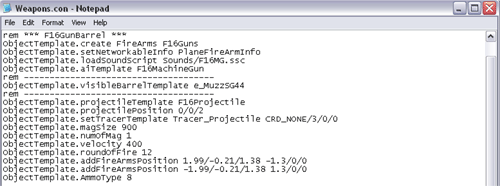
- In the line “ObjectTemplate.projectileTemplate F16Projectile”,
replace “F16Projectile” with “BazookaProjectile”.
***NOTE: The “BazookaProjectile” we are using as our
rocket projectile can be found in “Objects\HandWeapons\Common\Weapons.con”.
- In the line “ObjectTemplate.roundofFire 12”, replace
“12” with “2”.
***NOTE: Remember that the “ObjectTemplate.roundofFire”
value defines how fast the weapon will fire; the higher the value, the
faster the rate of fire.
Since we are adding a new type of weapon to the plane,
lets adjust the rotation of the weapon so that the rockets fire straight
at their target. To do this, we need to adjust the “ObjectTemplate.addFireArmsPosition”
lines.
- In the line “ObjectTemplate.addFireArmsPosition
1.99/-0.21/1.38 -1.3/0/0”, replace the “-1.3” with “0”.
- In the line ”ObjectTemplate.addFireArmsPosition
-1.99/-0.21/1.38 1.3/0/0”, replace the “1.3” with “0”.
***NOTE: The numerical values represent positional
and rotational coordinates.For example, the first set of numbers (“1.99/-0.21/1.38”)
dictate the position on the X/Y/Z axis. The second set of numbers (“-1.3/0/0”)
dictate the rotation on the X/Y/Z axis.
- Close and save the “Weapons.con” file.
Repack the “Objects.rfa” file and start the game to
see your changes in action.
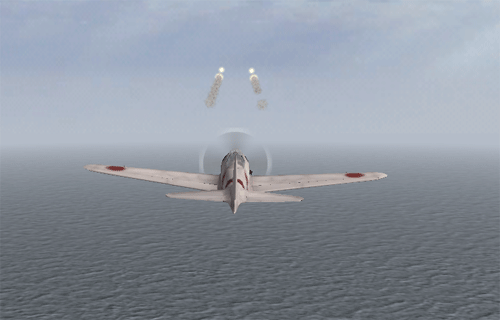
| 

